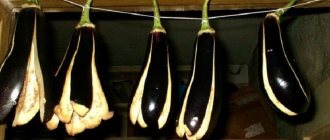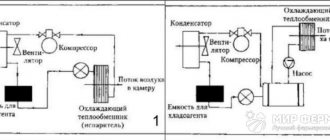Features of eggplant storage
The pulp of these vegetables contains a lot of active water , so they are not stored fresh for long.
Reference. Active (unbound) water accelerates biochemical processes in food products and promotes the spread of molds and other microorganisms. To prevent food spoilage, storage methods are used that inhibit internal chemical reactions: drying, freezing, canning.
The success of preserving fresh vegetables at home depends on three parameters :
- air humidity;
- temperature;
- illumination
Optimal temperature conditions for eggplants are +2…+6°C.
Suitable air humidity is 75–85%. Higher rates increase the risk of rot, and with low humidity the fruits lose their juiciness and wrinkle.
Lack of light is a prerequisite for storing this member of the nightshade family. When exposed to light, berries produce solanine, which is hazardous to health.
How long do fresh eggplants last?
Processed and canned vegetables last the longest. Average shelf life of fresh eggplants depending on storage location:
- cellar (basement) - 3-4 months;
- balcony (cold storage room) - 1 month;
- refrigerator - up to 2 weeks;
- at room temperature - about a week.
When is it time to remove eggplants from a bush in a greenhouse?
The ripening of eggplants lasts from 80 to 150 days and depends on the variety - they are early, medium and late. Vegetables are collected selectively as they ripen, and not all at once.
The following factors influence maturation:
- sowing time;
- variety and quality of seeds;
- weather;
- features of care.
During the ripening period, eggplants are harvested once every 5-7 days. They should not be allowed to become overripe - they become unsuitable for food.
Ripening time
Early varieties of eggplants are pleased with their rapid ripening. Their main advantage is resistance to low temperatures and poor lighting.
Within the group of early varieties and hybrids there are subgroups and favorites.
Ripening in 60-70 days:
- Valentina F1;
- Bibo F1;
- Fabina F1.
In 70-80 days:
- Nadir;
- Black handsome;
- Diamond.
In 90-100 days:
- Robin Hood;
- Giselle F1.
The ripening period for mid-early eggplant varieties and hybrids also varies.
Ripening in 100-115 days:
- White Night;
- Bull heart F1;
- Alekseevsky.
In 120-140 days:
- Sancho Panza;
- Black Moon F1;
- Namesake.
Eggplants of late varieties delight gardeners in the midst of autumn.
Ripening in 120-135 days:
- City F1;
- Black handsome.
In 135-150 days:
- Sophia;
- Bull forehead;
- Mishutka.
On average, from 1 sq. m of greenhouse, 5-7 kg of eggplants are harvested. One bush produces up to eight fruits.
Which eggplants are suitable for long-term storage?
In fresh form, late-ripening and mid-ripening varieties have the longest shelf life (for example, Torpeda, Romantika, Universal 6, Almaz).
To increase the period, the harvest is harvested in a timely manner (not earlier and not later) and the fruits are discarded according to shape and quality.
Fruit selection
High-quality eggplants are elastic with a dense, glossy skin , without deformation, mechanical damage and signs of rot and insect damage. The color and shape of the collected vegetables must correspond to the varietal characteristics.
Important! Both unripe and overripe eggplants are not suitable for long-term fresh storage. Consider the timing of technical ripeness of plants: for mid- and late-ripening varieties it is 120–130 days from the date of sowing.
The maturity of eggplants is also determined by their appearance . Overripe fruits, as a rule, have a matte skin, are lighter (as if faded), and have a soft structure. Unripe ones do not differ in color and size from ripe ones, but are noticeably lighter in weight.
When to harvest eggplants: harvest timing
As a rule, the technical ripeness of eggplant fruits occurs on average a month after they bloom.
Of course, earlier varieties ripen after 25 days, later ones - after 35-40 days. If you count from the moment of sowing seeds for seedlings, then this is approximately from 90 to 150 days. You can determine that eggplants are ready for harvesting by their shape and size, which must correspond to the variety (its characteristics), as well as the color of their skin, namely the characteristic glossy color of the surface. The shades of the surface of the skin also vary depending on the variety: the color is not only blue, dark purple, purple or lilac, but also white.
In addition, a ripe eggplant should have relatively white inside seeds and firm flesh. Naturally, this can only be checked experimentally, namely by cutting it in half.
As for the approximate dates for harvesting eggplants, on average it is August-September (in the south, with early planting of seedlings - from the second half of July).
If you cut the fruits too early, they will shrink (wither) very quickly and lose their taste.
If, on the contrary, you let them overripe, the color of the fruit will become “brown” (not glossy, but matte), the flesh will not be white, but brown, hard and tasteless (with a bitter aftertaste), and the seeds will be dark.
Video: harvesting eggplants
How to harvest
When harvesting, follow the following recommendations and rules:
- It is best to cut fruits in dry weather.
- Eggplants are not harvested immediately, but gradually as they ripen (every 5-7 days), choosing the most ripe fruits.
- It is most convenient to cut the fruits with pruning shears or use a sharp knife.
- When cutting, it is recommended to leave a small tail up to 4-5 cm long.
- You cannot wash the fruits after picking for storage, which is why it is recommended to collect them only in dry weather.
Video: when and how to cut eggplants and then store them
Preparing eggplants for storage
Vegetables are harvested in dry weather, but not in the very heat . Cut specimens suitable for ripeness, leaving stalks 3–5 cm long.
Before storing, cut eggplants are ventilated for a day in the fresh air , protected from direct sunlight (covered with burlap, put in the shade). A dark room with good ventilation is suitable for drying vegetables. If ventilation is not possible, wipe the fruits with a dry cloth.
Important! Eggplants intended for fresh storage should never be washed. Water removes the protective coating from the skin and reduces the natural biological immunity of vegetables.
How to store eggplants at home
When keeping unprocessed eggplants, the main goal is to preserve their beneficial properties, freshness, juiciness and texture.
Cellar or basement
These places are most suitable for long-term storage of vegetables . Temperature, humidity, shading in the basement conditions are close to optimal. The main thing is that the indicators remain stable, without sudden changes.
The most popular storage methods in the cellar:
- laying in layers on the ground/floor/shelves (previously covered with straw);
- storage in boxes with holes;
- storage in hanging nets.
In the vegetable storehouse, air ventilation and insulation of fruits are provided . To do this, eggplants are wrapped in paper and laid in layers sprinkled with sawdust, ash or river sand.
Important! Do not forget to sort through vegetables from time to time, choosing spoiled ones, and monitor the microclimate in the room.
Balcony
On an insulated (glazed) balcony, fresh eggplants are kept in boxes . The bottom is covered with a thick bedding of straw, the vegetables laid in layers are covered with dry sand or ash. The boxes are covered with burlap on top to protect them from light and cold. When the air temperature drops below +2°C, vegetables are insulated by throwing on, for example, an old blanket or rug.
Fresh eggplants are stored on the balcony for about a month, depending on the weather.
Other methods
Other storage methods involve heat treatment, which increases the shelf life of products . In such cases, early ripening varieties of eggplant are also used, and the requirements for the quality of the fruits themselves are reduced.
In the freezer
Freezing is an economical storage method , especially for city residents who do not have a cellar or basement.
Important! Properly frozen vegetables preserve their vitamin and taste properties and save time when using them for food.
How to prepare eggplants for freezing:
- Washing, peeling and slicing - the fruits are cut into cubes, rings, slices, large pieces, and left whole.
- Soaking in salt water removes bitterness. The duration of the procedure is 0.5–1 hour, depending on the size of the pieces.
- Preliminary heat treatment prevents the quality and taste of the pulp from deteriorating.
The simplest heat treatment includes:
- blanching - boiling for 5 minutes in salted water;
- light baking in the oven or frying in a pan.
After heat treatment, lay the eggplants on a paper napkin to drain excess oil and cool.
It is better to freeze in portions so that the pieces do not stick together. To do this, the processed slices are laid out on a tray (board, baking sheet) in one layer and sent to the freezer.
After the pieces have frozen to the required hardness, they are poured into bags or containers, and the next portion of eggplants is placed on the tray.
Semi-finished products prepared in this way are stored in airtight containers for quite a long time , up to a year. In winter, they are used to prepare vegetable stews, appetizers, side dishes and other dishes.
Dried
dried vegetables does not require the creation of special conditions . However, there is an opinion that dishes prepared from such eggplants do not taste good.
There are three ways to dry eggplants:
- in the oven;
- in an electric dryer;
- on open air.
In the first case, washed and chopped fruits are spread in a thin layer on a baking sheet (without oil) and placed in an oven preheated to +200°C. Drying is carried out at a temperature of +100°C for 5-6 hours with the door ajar.
It is convenient to dry vegetables in an electric dryer , where the appropriate mode and time are set (on average 7-8 hours).
The third method is the least reliable , since dry weather is required throughout the entire period for a high-quality result. Eggplants, cut into pieces 1.5–2 cm thick, are loosely strung on a thread or laid out in a thin layer on a flat surface. Dry them in a shaded, dry place with good ventilation for about 5–7 days.
The finished pieces are packaged in paper bags, fabric bags or other airtight containers and stored at room temperature. Such preparations are suitable for food for at least a year.
Reference. A type of dried vegetables is dried. To do this, the fruits are partially dehydrated, and the temperature and duration of drying are reduced. Such semi-finished products are stored in the refrigerator, in glass jars filled with vegetable oil.
Canned
The most common way to preserve crops is canning . Eggplants are salted, fermented, pickled, prepared in the form of salads or traditional eggplant caviar.
There are many recipes for cooking vegetables, especially in the national cuisines of southern countries. Below are some simple options.
Salted eggplants
Place chopped fruits in an enamel pan (or other container for pickling), add chopped dill and garlic to taste, sprinkle with salt (at the rate of 2-3% relative to the weight of vegetables), and mix.
The workpiece is aged under pressure for 2–4 days at room temperature until the brine becomes cloudy. Store the finished pickles in a cool place (for example, a refrigerator). After a week, the eggplants are ready to eat.
Pickled eggplants
Whole fruits are cut lengthwise to 2/3 of the thickness and boiled in plenty of salted water for 10 minutes. For the filling, grated carrots, chopped herbs, garlic, walnuts, etc. are used in various combinations. Minced meat is generously added to the inside of each eggplant (in the cut).
The fruits are wrapped with threads so that they do not fall apart. The stuffed vegetables are placed in an enamel pan and completely filled with brine (1.5 liters of water, 80–90 g of salt). The fermentation is infused under pressure for several days, then transferred to a cool place for storage.
Eggplant appetizer with vegetables
Vegetables are cut into slices, add salt and fry in a frying pan. Fried eggplants are placed in sterilized jars in layers, alternating them with fresh peppers, tomatoes, carrots, onions, celery, and parsley.
The layers are sprinkled with salt, pepper, and spices to taste. The mixture is poured with heated vegetable oil, the jars are sterilized in the usual way. The preparations are stored at room temperature.
Storing vegetables in the freezer
Another type of eggplant storage is freezing at a temperature of −12 ℃. This is the best option for those who live in a city apartment and do not have access to a cellar. Frozen vegetables retain their beneficial properties and also significantly save time when preparing food.
The taste of fresh eggplants deteriorates greatly when frozen. (Even if you take white or green varieties that are not bitter). The method of freezing fried or baked “semi-finished product” seems much more correct if you don’t want or can’t make canned eggplants.
The classic way to freeze eggplants:
- Wash the vegetables well under running water.
- Cut the eggplants into cubes, circles or slices.
- Place the vegetables in a deep bowl and add salt. After 30-40 minutes, drain the juice, which will remove all the bitterness of the eggplants.
- Blanch the vegetables for 5 minutes and then drain them in a colander to drain excess liquid.
- Place the prepared fruits on a cutting board and place in the freezer. It is better to choose a separate box for this, since eggplants quickly absorb foreign odors.
- After a few hours, take out the workpiece and put the products into bags. This method of freezing will prevent the vegetables from sticking together.
To save space and ease of use, cut the eggplants into circles, cubes or slices before freezing.
You can also freeze baked eggplants . Wash the vegetables well, cut into slices and bake in the oven. You can use spices or herbs to add flavor. Cover the cooled eggplants with cling film and place in the freezer.
Eggplants cannot be re-frozen, so remove only enough vegetables from the freezer to use at one time.
a preparation of fried eggplants will help you save time when cooking . First of all, wash the vegetables, dry them and cut them into slices or cubes. Boil the eggplants for 5 minutes in salted water and then fry in oil. Place the products in bags and put them in the freezer.
Properly frozen eggplants retain nutrients and taste.
Useful tips
For successful storage of fresh eggplants at home:
- vegetables are provided with suitable conditions: a cool, dark place with constant humidity of about 80%;
- use ventilated boxes with holes or baskets: vegetables deteriorate rapidly in closed, tight containers;
- isolate fresh fruits from each other and from the external environment (the best solution is bags made of thick paper: they are gas-permeable and provide the necessary darkening, protect vegetables from drying out and rotting);
- limit the contact of eggplants with other vegetables and fruits that produce ethylene during ripening (tomatoes, bananas, apricots, plums, pears).











